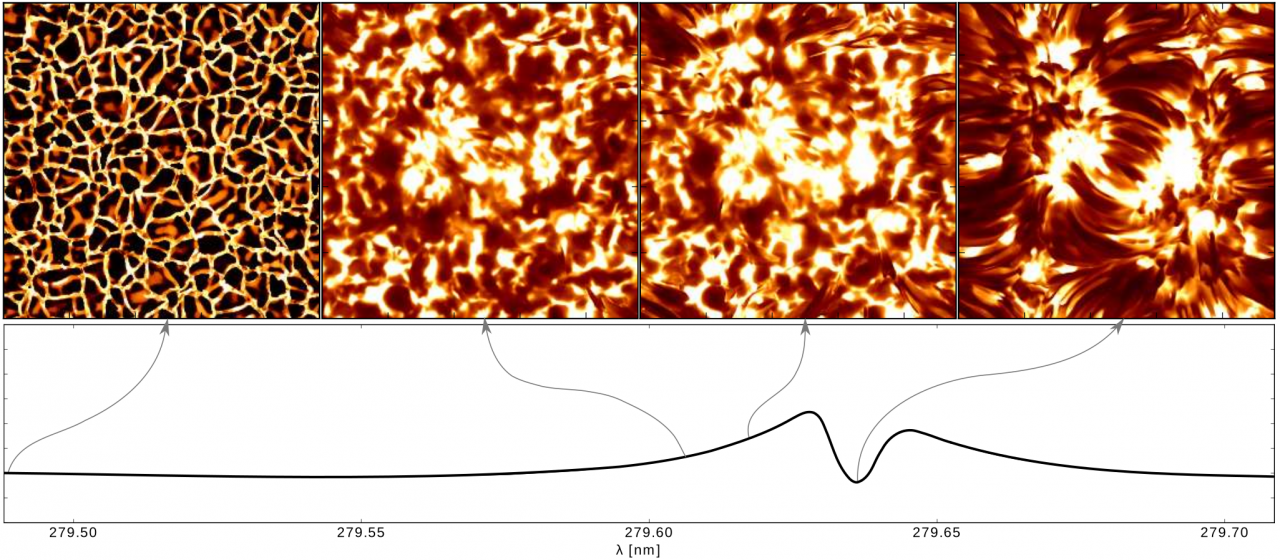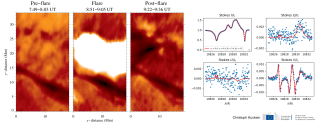General
Los campos magnéticos están presentes en todos los plasmas astrofísicos y controlan la mayor parte de la variabilidad que se observa en el Universo a escalas temporales intermedias. Se encuentran en estrellas, a lo largo de todo el diagrama de Hertzsprung-Russell, en galaxias, e incluso quizás en el medio intergaláctico. La polarización de la luz proporciona la fuente más fiable de información para la teledetección de campos magnéticos en Astrofísica, incluyendo los campos magnéticos del Sol. En particular, el diagnóstico de campos magnéticos en las atmósferas del Sol y de otras estrellas requiere de la medida e interpretación física de señales de polarización en líneas espectrales, las cuales son inducidas por varios mecanismos físicos que operan a las escalas atómicas. Además del efecto Zeeman, hay muchos otros mecanismos físicos que producen polarización en la radiación electromagnética. Por ejemplo, la polarización de los niveles atómicos o moleculares inducida por el bombeo óptico de un campo de radiación anisótropo, la interferencia cuántica entre niveles de estructura fina o hiperfina, el efecto Hanle, etc. La polarización generada por tales mecanismos es sensible a las condiciones físicas del plasma astrofísico en consideración y, en particular, a la presencia de campos magnéticos en un rango de intensidades que va desde valores tan bajos como 1 microgauss hasta varios miles de Gauss.
El principal objetivo de este proyecto es explorar, en profundidad, la física y el origen de la radiación polarizada en plasmas astrofísicos, así como su utilidad como medio de diagnóstico para descifrar y entender la actividad magnética en Astrofísica, con énfasis en el magnetismo de la atmósfera solar. Nuestras investigaciones involucran:
- la física de la polarización, lo que requiere profundizar en la teoría cuántica de la interacción radiación-materia, teniendo en cuenta procesos de dispersión en presencia de campos magnéticos y eléctricos.
- el desarrollo de técnicas de diagnóstico de plasmas para la exploración de campos magnéticos en Astrofísica, con particular interés en descifrar el complejo magnetismo de la atmósfera solar, envolturas circunestelares y nebulosas planetarias.
- observaciones espectropolarimétricas y su interpretación en términos de modelos físicos.
- desarrollo de métodos numéricos para la solución de problemas de transporte radiativo sin suponer equilibrio termodinámico local, con aplicaciones a modelos tri-dimensionales de atmósferas estelares resultantes de simulaciones magneto-hidrodinámicas.
- espectroscopia y espectropolarimetría atómica y molecular, con aplicaciones en varios campos de la Astrofísica.
Este Proyecto está formado por un grupo de científicos convencidos de la importancia de complementar investigaciones teóricas, observacionales e instrumentales para hacer frente a algunos de los retos actuales de la Astrofísica.
Miembros
Resultados
- Hemos aplicado técnicas de aprendizaje profundo al análisis de observaciones. Utilizando redes neuronales convolucionales, hemos desarrollado técnicas para la deconvolución de observaciones. Estas técnicas fueron también utilizadas en el proceso de deconvolución de observaciones en Tierra, consiguiendo una cadencia de unas cien imágenes procesadas por segundo.
- Hemos desarrollado una técnica de inferencia bayesiana para interpretar las observaciones proporcionadas por el experimento internacional CLASP. Parametrizando un modelo magneto-hidrodinámico de vanguardia de la atmósfera solar encontramos que la complejidad geométrica de la región de transición debe ser mucho mayor que la que se encuentra en el modelo.
- Hemos resuelto el problema de la propagación de radiación polarizada en simulaciones de magneto-convección con acción dinamo local para la línea de Sr I en 460.7nm. Encontramos que el modelo con la mayor parte de la zona de convección con magnetización cercana a la equipartición y con campo superficial promedio de 170G es compatible con las observaciones disponibles.
- Hemos estudiado la sensibilidad magnética de la línea de Ca I en 422.7nm. La polarización lineal en el centro de la línea es sensible al efecto Hanle, mientras que en las alas es sensible a efectos magneto-ópticos como consecuencia de la acción conjunta de la redistribución parcial y el efecto Zeeman, un mecanismo encontrado recientemente.
- Hemos estudiado la formación de las líneas H-alfa, Mg II h-k y Ca II H-K y 854.2nm en un modelo de región bipolar explosiva, resolviendo el problema de transporte de radiación teniendo en cuenta redistribución parcial en geometría 3D y fuera del equilibrio termodinámico local. Conseguimos reproducir características propias de las observaciones de estas regiones.
Actividad científica
Publicaciones relacionadas
-
DeepVel: Deep learning for the estimation of horizontal velocities at the solar surface
Many phenomena taking place in the solar photosphere are controlled by plasma motions. Although the line-of-sight component of the velocity can be estimated using the Doppler effect, we do not have direct spectroscopic access to the components that are perpendicular to the line of sight. These components are typically estimated using methods based
Asensio Ramos, A. et al.Fecha de publicación:
72017 -
Search for torsional oscillations in isolated sunspots
In this work we seek evidence for global torsional oscillations in alpha sunspots. We have used long time series of continuum intensity and magnetic field vector maps from the Helioseismic and Magnetic Imager (HMI) instrument on board the Solar Dynamics Observatory (SDO) spacecraft. The time series analysed here span the total disk passage of 25
Griñón-Marín, A. B. et al.Fecha de publicación:
72017 -
Numerical simulations of quiet Sun magnetic fields seeded by the Biermann battery
The magnetic fields of the quiet Sun cover at any time more than 90% of its surface and their magnetic energy budget is crucial to explain the thermal structure of the solar atmosphere. One of the possible origins of these fields is the action of the local dynamo in the upper convection zone of the Sun. Existing simulations of the local solar
Khomenko, E. et al.Fecha de publicación:
82017 -
A Hot Downflowing Model Atmosphere for Umbral Flashes and the Physical Properties of Their Dark Fibrils
We perform non-LTE inversions in a large set of umbral flashes, including the dark fibrils visible within them, and in the quiescent umbra by using the inversion code NICOLE on a set of full Stokes high-resolution Ca ii λ8542 observations of a sunspot at disk center. We find that the dark structures have Stokes profiles that are distinct from those
Henriques, V. M. J. et al.Fecha de publicación:
82017 -
CLASP/SJ Observations of Rapid Time Variations in the Lyα Emission in a Solar Active Region
The Chromospheric Lyα SpectroPolarimeter (CLASP) is a sounding rocket experiment launched on 2015 September 3 to investigate the solar chromosphere and transition region. The slit-jaw (SJ) optical system captured Lyα images with a high time cadence of 0.6 s. From the CLASP/SJ observations, many variations in the solar chromosphere and transition
Ishikawa, Sh.-N. et al.Fecha de publicación:
92017 -
The Physics and Diagnostic Potential of Ultraviolet Spectropolarimetry
The empirical investigation of the magnetic field in the outer solar atmosphere is a very important challenge in astrophysics. To this end, we need to identify, measure and interpret observable quantities sensitive to the magnetism of the upper chromosphere, transition region and corona. This paper provides an overview of the physics and diagnostic
Trujillo Bueno, J. et al.Fecha de publicación:
92017 -
Design of an adaptable Stokes polarimeter for exploring chromospheric magnetism
The chromosphere is a highly complex and dynamic layer of the Sun, that serves as a conduit for mass and energy supply between two, very distinct regions of the solar atmosphere, namely, the photosphere and corona. Inferring magnetic fields in the chromosphere, has thus become an important topic, that can be addressed with large-aperture solar
Louis, R. E. et al.Fecha de publicación:
102017 -
Chromospheric impact of an exploding solar granule
Context. Observations of multi-wavelength and therefore height-dependent information following events throughout the solar atmosphere and unambiguously assigning a relation between these rapidly evolving layers are rare and difficult to obtain. Yet, they are crucial for our understanding of the physical processes that couple the different regimes
Rezaei, R. et al.Fecha de publicación:
62017 -
Discovery of Scattering Polarization in the Hydrogen Lyα Line of the Solar Disk Radiation
There is a thin transition region (TR) in the solar atmosphere where the temperature rises from 10,000 K in the chromosphere to millions of degrees in the corona. Little is known about the mechanisms that dominate this enigmatic region other than the magnetic field plays a key role. The magnetism of the TR can only be detected by polarimetric
Kano, R. et al.Fecha de publicación:
42017 -
Penumbral thermal structure below the visible surface
Context. The thermal structure of the penumbra below its visible surface (i.e., τ5 ≥ 1) has important implications for our present understanding of sunspots and their penumbrae: their brightness and energy transport, mode conversion of magneto-acoustic waves, sunspot seismology, and so forth. Aims: We aim at determining the thermal stratification
Borrero, J. M. et al.Fecha de publicación:
52017 -
Indication of the Hanle Effect by Comparing the Scattering Polarization Observed by CLASP in the Lyα and Si iii 120.65 nm Lines
The Chromospheric Lyman-Alpha Spectro-Polarimeter is a sounding rocket experiment that has provided the first successful measurement of the linear polarization produced by scattering processes in the hydrogen Lyα line (121.57 nm) radiation of the solar disk. In this paper, we report that the Si iii line at 120.65 nm also shows scattering
Ishikawa, R. et al.Fecha de publicación:
52017 -
The Polarization Signature of Photospheric Magnetic Fields in 3D MHD Simulations and Observations at Disk Center
Before using three-dimensional (3D) magnetohydrodynamical (MHD) simulations of the solar photosphere in the determination of elemental abundances, one has to ensure that the correct amount of magnetic flux is present in the simulations. The presence of magnetic flux modifies the thermal structure of the solar photosphere, which affects abundance
Beck, C. et al.Fecha de publicación:
62017 -
The dusty tori of nearby QSOs as constrained by high-resolution mid-IR observations
We present mid-infrared (MIR; 7.5-13.5 μm) imaging and spectroscopy observations obtained with the CanariCam (CC) instrument on the 10.4-m Gran Telescopio CANARIAS for a sample of 20 nearby, MIR bright and X-ray luminous quasi-stellar objects (QSOs). We find that for the majority of QSOs the MIR emission is unresolved at angular scales ∼0.3 arcsec
Martínez-Paredes, M. et al.Fecha de publicación:
62017 -
Uncertainties in the solar photospheric oxygen abundance
Aims: The purpose of this work is to better understand the confidence limits of the photospheric solar oxygen abundance derived from three-dimensional models using the forbidden [OI] line at 6300 Å, including correlations with other parameters involved. Methods: We worked with a three-dimensional empirical model and two solar intensity atlases
Cubas Armas, M. et al.Fecha de publicación:
32017 -
The Physical Origin and Magnetic Sensitivity of the Scattering Polarization Observed in the O i IR Triplet at 777 nm
The linearly polarized solar limb spectrum caused by the absorption and scattering of anisotropic radiation has a very rich diagnostic potential, given its sensitivity to the thermal, dynamic, and magnetic structure of the solar atmosphere. A crucial first step toward its scientific exploitation is understanding the physical origin of the observed
del Pino Alemán, T. et al.Fecha de publicación:
42017 -
Polarization Calibration of the Chromospheric Lyman-Alpha SpectroPolarimeter for a 0.1% Polarization Sensitivity in the VUV Range. Part II: In-Flight Calibration
The Chromospheric Lyman-Alpha SpectroPolarimeter is a sounding rocket instrument designed to measure for the first time the linear polarization of the hydrogen Lyman-{α} line (121.6 nm). The instrument was successfully launched on 3 September 2015 and observations were conducted at the solar disc center and close to the limb during the five-minutes
Giono, G. et al.Fecha de publicación:
42017 -
The Transfer of Resonance Line Polarization with Partial Frequency Redistribution in the General Hanle–Zeeman Regime
The spectral line polarization encodes a wealth of information about the thermal and magnetic properties of the solar atmosphere. Modeling the Stokes profiles of strong resonance lines is, however, a complex problem both from a theoretical and computational point of view, especially when partial frequency redistribution (PRD) effects need to be
Alsina Ballester, E. et al.Fecha de publicación:
22017 -
Inference of the chromospheric magnetic field orientation in the Ca ii 8542 Å line fibrils
Context. Solar chromospheric fibrils, as observed in the core of strong chromospheric spectral lines, extend from photospheric field concentrations suggesting that they trace magnetic field lines. These images have been historically used as proxies of magnetic fields for many purposes. Aims: Use statistical analysis to test whether the association
Asensio Ramos, A. et al.Fecha de publicación:
32017 -
First Detection of Sign-reversed Linear Polarization from the Forbidden [O I] 630.03 nm Line
We report on the detection of linear polarization of the forbidden [O i] 630.03 nm spectral line. The observations were carried out in the broader context of the determination of the solar oxygen abundance, an important problem in astrophysics that still remains unresolved. We obtained spectro-polarimetric data of the forbidden [O i] line at 630.03
de Wijn, A. G. et al.Fecha de publicación:
22017 -
Synthetic polarimetric spectra from stellar prominences
Stellar prominences detected in rapidly rotating stars serve as probes of the magnetism in the corona of cool stars. We have synthesized the temporal evolution of the Stokes profiles generated in the He I 10 830 and 5876 Å triplets during the rotation of a prominence around a star. The synthesis was performed with the HAZEL code using a cloud model
Felipe, T. et al.Fecha de publicación:
22017



